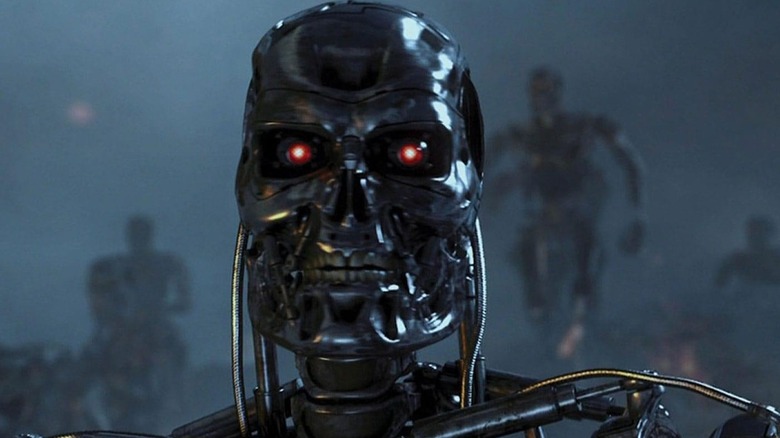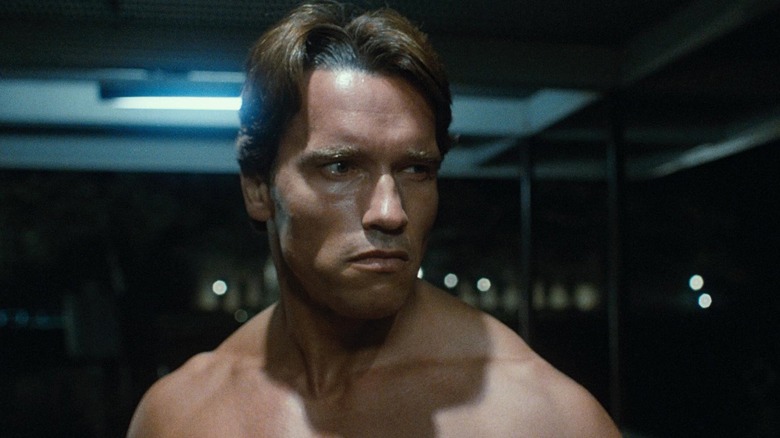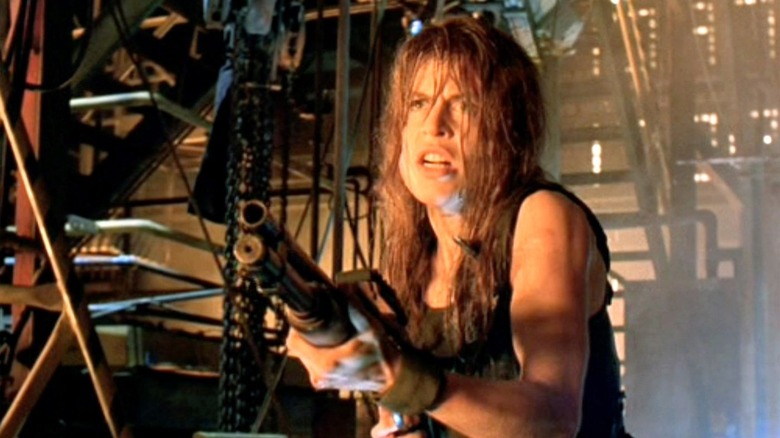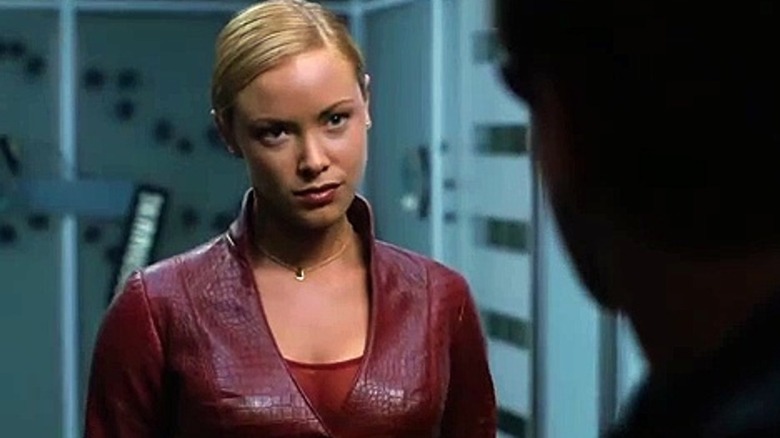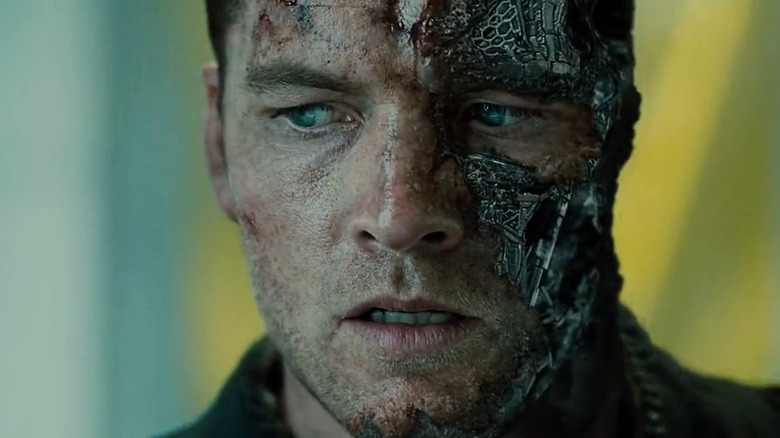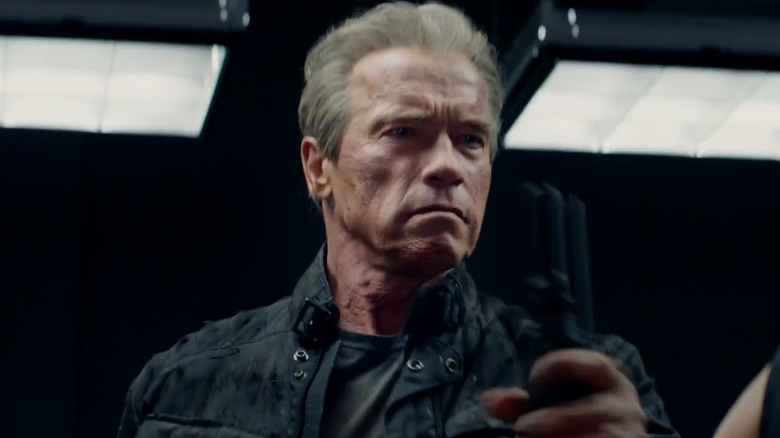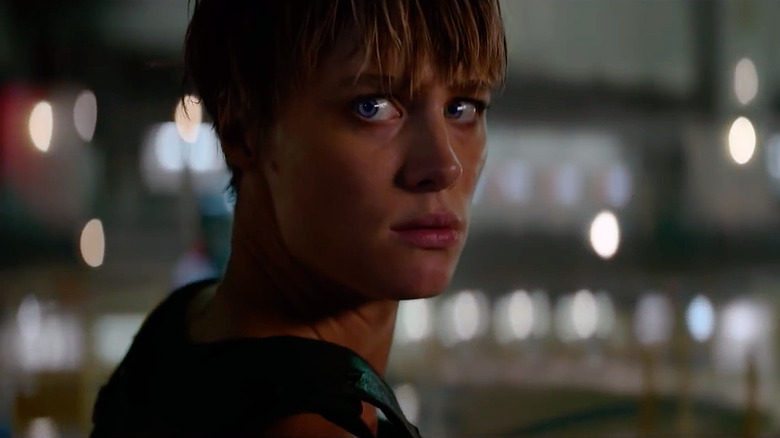The Ending Of Every Terminator Movie Explained
The "Terminator" franchise is the longest-running time travel series in film (at least, among action movies with time travel in them). Despite the convoluted later entries in the franchise, "Terminator" began as a brilliant mix of sci-fi and action filmmaking that blew audiences away at the time. The stories keep coming, but the constants stay the same — Arnold Schwarzenegger, John Connor, Skynet, and sending machines back in time to prevent the future. This is what defines "Terminator."
So it makes sense that as the series went on, the timeline became more complicated, leading to some head-scratchers along the way. With so many diverging timelines, it gets hard to keep track of each movie's ending and how they tie back to the impending war between humans and machines that (nearly) every "Terminator" focuses on trying to prevent. With the most recent entry, "Dark Fate," adding yet another wrinkle to the fold, we felt it was a good time to run through each movie and explain the endings one by one.
The Terminator
At the beginning of James Cameron's classic, "Terminator," we see two men sent back to 1984 to change the fate of the planet. One is a hulking machine with the face and skin of a man — that's our Arnold, here to terminate Sarah Connor. The other is Kyle Reese, a soldier sent by Sarah's son John to ensure her survival and the birth of John Connor, the future leader of the human resistance. John gives Reese a photograph of Sarah to identify her, and Reese ends up cherishing it and falling in love with her once they meet, conceiving John. This is the big time travel moment of "The Terminator," and the ending feeds directly back into it, making the potentially ludicrous story come together so neatly that no one batted an eye.
In the climactic moments of the film, Reese sacrifices his life to save Sarah, completing his destiny (at least in this timeline). She escapes, and the movie cuts to months later, where we see that she is visibly pregnant. Sarah records messages for John, telling him of his future role in a scene that retroactively sets up their relationship in the sequel. And then, at the very end, we see the photograph that John later gives to Reese being taken, and the movie comes full circle.
Terminator 2: Judgment Day
Regardless of which side you land on in the "Terminator" versus "Terminator 2" debate, you still have to recognize them as two of the best action movies of all time. Cameron's sequel to "The Terminator ” is non-stop greatness that proves you don't need convoluted twists to make a compelling time travel story, and as such, it probably has the most straightforward ending in the series. In its simplicity, "Judgment Day" also brings something to the table the other movies lack: hope.
Sarah and John Connor drive away after Model 101 (Arnold) — which turns into a protector in the sequel's subversion of the original — saves them from the T-1000. Memorably, Arnold's Model 101 tosses himself into a vat of molten steel, explaining he must also be destroyed or Skynet will be created, and all their actions will be for naught. As they drive away, Sarah becomes filled with hope from 101's sacrifice, for once being able to see a future where machines and humans can potentially live in harmony.
Terminator 3: Rise of the Machines
While it's far from the best "Terminator" movie, "Terminator 3" might just have the best ending of the bunch. Essentially a twist ending, "Rise of the Machines" is revealed to be the "bad timeline" movie where the machines win the war and Skynet achieves global domination. At the end of the mindless time travel romp that is "Terminator 3", John Connor and his future wife Kate end up at Crystal Peak, where they are told they can put an end to Skynet once and for all. This was their destination all along, but it is revealed to not be Skynet's core. Instead, it is a fallout shelter, and the end of the human race is imminent. The machines have won from the beginning, and there was no way of stopping them. Judgment Day arrives.
This take on John's destiny is a subversion of the expectations of the other movies. He was never meant to win the war — that was an impossibility. Instead, his purpose was to survive Judgment Day in order to restart the human race with Kate.
Terminator: Salvation
"Terminator: Salvation" is the franchise's take on a war movie and is the only one that takes place entirely after "Judgment Day." Starring Christian Bale as John Connor and Anton Yelchin as Kyle Reese, "Salvation" follows these characters as they attempt a covert mission to shut down Skynet's machine army. The ending of this one is fairly straightforward: In the final moments of the plot, John Connor nearly gives his life rescuing Kyle Reese to ensure that he would be born in the first place. Marcus (Sam Worthington) — revealed earlier to be part machine — sacrifices himself with a last-minute change of heart, literally giving his heart to save John.
According to director McG, the original ending the filmmakers had in mind was much darker. "Connor dies, we're in a room with all the people we care about," the director told io9. "You take Connor's likeness, you put it on the living machine of Marcus. He sits up, now looking like Christian Bale, takes a gun, kills Kate, kills Kyle, kills Star, kills everybody, eyes flare red, [snaps] the end."
Screenwriter Michael Ferris says this wasn't the only version of this ending that was under consideration. One scrapped ending showed Connor's face on Marcus's body but did not include the evil turn. The irony here is that the leader of the resistance is now a machine.
Terminator Genisys
"Terminator Genisys" was an attempt to reboot the series by doing what the series does best and worst — making a sequel to "The Terminator." What boils down to an alternate timeline version of Skynet's rise ends up being the most complicated and convoluted in the series' long history. The confusing writing of the movie applies to the way it ends as well. But to explain the end, we must start at the beginning.
While traveling back to 1984, Kyle Reese (Jai Courtney) experiences visions from an alternate childhood he never lived. This splintering of the timeline leads to Kyle taking Sarah Connor from 1984 and the pair traveling to 2017, where the upcoming launch of an OS named Genisys will lead to the creation of Skynet. With the help of "Pops" (this timeline's friendly version of Arnold Schwarzenegger's Terminator), they stop an evil John Connor and take down Genisys. To close the loop, the trio visits a teenage Kyle Reese in order to create the vision Reese sees at the beginning of the movie, which is the clue that led to the destruction of Genisys. To put it plainly, Kyle Reese needs to tell the younger version of himself to give the future version of himself the warning that causes this timeline to exist — if that can be considered plain.
After all these time travel shenanigans, a mid-credits sequence shows it doesn't really matter — Genisys survived the attack, setting up the direct sequels that were planned but never made after the poor reception of "Genisys."
Terminator: Dark Fate
The latest "Terminator" movie is known more for its controversial — and secretly great — opening sequence than its ending. In the film's first moments, we see Sarah Connor and a young, CGI-d John Connor on a beach, enjoying some much-needed R&R. And then, out of nowhere, the T-800 (Arnold Schwarzenegger) comes to kill John. He succeeds, and "Dark Fate" diverges from the timeline. The production brought back Linda Hamilton and roped in James Cameron as a producer to create the most-liked movie in the franchise since "T2." Still, the final moments were a bit vague with regards to where the future of "Terminator" is heading and if we will see these characters again.
In the climactic sequence of "Dark Fate," genetically enhanced cyber-soldier Grace (Mackenzie Davis) sacrifices herself so Dani (Natalia Reyes) can use her power source to defeat the Rev-9 Terminator — this movie's main antagonistic machine. This is Grace's fate, and it needs to happen in order for Dani to live and one day lead the resistance. In the final scene, Sarah Connor and Dani visit the living child version of Grace, who is currently 10 years old. Dani wants to be able to save her and prevent the events of the movie, but Sarah knows they are inevitable. This scene is about Dani accepting that in the future, she will send Grace to die and must go through with it. If not, Dani will die in her stead, and the machines will win. A dark fate indeed.
